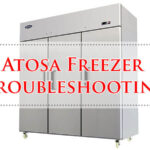
If your Kenmore Elite fridge is not cooling, there may be a problem with the condenser fan motor or the condenser coils. Check if something is caught in the condenser fan motor blade or if the motor itself is defective.
The condenser fan motor draws air over the coils to cool them, so if it’s not working properly, the fridge won’t cool. This motor is located underneath the fridge, near the back. If cleaning the coils or replacing the fan motor doesn’t solve the issue, it’s best to consult a professional for further troubleshooting and repair.
Possible Causes For A Kenmore Elite Fridge Not Cooling
If your Kenmore Elite fridge is not cooling, it could be due to a variety of issues. Some possible causes include a malfunctioning condenser fan motor, dirty condenser coils, or a faulty gasket seal. It is important to check these components and ensure proper ventilation to resolve the cooling issue.
If you’re experiencing a Kenmore Elite fridge not cooling, several potential causes might be responsible for this issue. Below, we’ll explore some common culprits that could be affecting your fridge’s cooling abilities.
Clogged condenser coils:
- Dust and debris can accumulate on the condenser coil over time, hindering the fridge’s cooling abilities.
- To fix this issue, simply clean the condenser coils to remove any dirt or buildup.
Defective condenser fan motor:
- A faulty condenser fan motor can hamper the cooling process in your Kenmore Elite fridge.
- If the condenser fan motor is not working properly, it might need to be replaced to restore proper cooling.
Faulty Compressor:
- The compressor is responsible for circulating refrigerant and maintaining the desired temperature inside the fridge.
- If the compressor is defective, it will not be able to cool the fridge effectively. In such cases, replacing the compressor may be necessary.
Malfunctioning Temperature Sensor:
- A malfunctioning temperature sensor can inaccurately gauge the temperature inside the fridge, leading to cooling issues.
- To resolve this problem, the temperature sensor may need to be repaired or replaced.
Damaged Air Damper:
- The air damper regulates the flow of cold air from the freezer to the fridge. If it is damaged, it can disrupt the cooling process.
- Replacing the damaged air damper should rectify the cooling issue.
Issues with Cold Control:
- The cold control regulates the temperature inside the fridge. If it is not functioning correctly, it can prevent proper cooling.
- Troubleshooting or replacing the cold control mechanism might be necessary to resolve the cooling problem.
Remember, diagnosing the exact cause of a Kenmore Elite fridge not cooling requires technical knowledge and expertise. If you’re unsure about troubleshooting or repairing your fridge, it’s best to consult a professional technician for assistance.
By addressing these possible causes for a Kenmore Elite fridge not cooling, you can potentially resolve the cooling issue and restore your fridge’s functionality.
Step 1: Checking The Condenser Coils
If your Kenmore Elite fridge is not cooling, the first step is to check the condenser coils. These coils can get dirty or blocked, preventing proper cooling. Locate the condenser coils underneath the refrigerator near the back and clean them to see if that resolves the issue.
The condenser coils in your Kenmore Elite fridge play a crucial role in cooling down the refrigerator. If the coils are dirty or covered in debris, they may be preventing the fridge from cooling properly. Here’s what you need to do to check the condenser coils:
- Removing debris from the coils: Start by disconnecting the power to the refrigerator. Locate the condenser coils, which are usually found at the back of the fridge. Use a vacuum cleaner or a brush to carefully remove any debris or dust that may have accumulated on the coils.
- Cleaning the coils: Once the debris is removed, take a closer look at the coils. If they are still dirty, you will need to clean them thoroughly. You can use a coil brush or a soft-bristle brush to gently scrub away any dirt or grime. Make sure to brush both sides of the coils.
- Inspecting for damage: After cleaning the coils, inspect them for any signs of damage or corrosion. If you notice any bent fins or other issues, you may need to replace the coils. Contact a professional technician or the manufacturer for assistance.
- Reassembling the fridge: Once the coils are clean and in good condition, carefully reassemble the fridge and plug it back in. Give it some time to cool down and monitor the temperature to see if the issue has been resolved.
Remember, checking and cleaning the condenser coils is just the first step in troubleshooting a Kenmore Elite fridge that is not cooling properly. If the issue persists, you may need to explore other possible causes or seek professional help.
Step 2: Inspecting The Condenser Fan Motor
Inspecting the condenser fan motor is an important step in troubleshooting a Kenmore Elite fridge that is not cooling. The condenser fan motor is responsible for drawing air over the condenser coils to cool them, so if it is defective or blocked by debris, it could be the cause of the cooling issue.
If your Kenmore Elite fridge is not cooling properly, the condenser fan motor could be the culprit. The condenser fan motor plays a crucial role in cooling the condenser coils that remove heat from the refrigerator. Here’s how to test and inspect the condenser fan motor:
- Start by unplugging the refrigerator from the power source to ensure safety.
- Locate the condenser fan motor, which is usually found at the back of the fridge near the compressor.
- Check for any visible signs of damage or obstruction, such as debris or ice buildup, that could be preventing the fan from spinning properly.
- Gently spin the fan blades with your hand to see if they rotate freely. If the blades are stuck or difficult to turn, there may be a problem with the motor.
- Plug the refrigerator back in and listen for any unusual noises coming from the condenser fan motor. Excessive noise or a grinding sound could indicate a faulty motor.
- Using a multimeter on the resistance setting, test the motor’s continuity by touching the probes to the terminals on the motor. A reading of infinity or no reading at all indicates a faulty motor that needs to be replaced.
Testing the motor:
To test the condenser fan motor, follow these steps:
- Remove the wiring harness from the motor terminals.
- Set your multimeter to the resistance setting.
- Touch the multimeter probes to the motor terminals.
- A reading of approximately 0–30 ohms indicates that the motor is functioning properly.
- If the reading is outside of this range or there is no reading at all, it means that the motor is faulty and needs to be replaced.
Replacing the motor if necessary:
If the condenser fan motor is defective and needs to be replaced, here’s what you can do:
- Before starting any repair work, ensure that the refrigerator is unplugged to prevent any electrical mishaps.
- Locate the mounting bracket that holds the motor in place.
- Remove any screws or clips securing the motor to the bracket.
- Disconnect the wiring harness from the motor.
- Install the new condenser fan motor by reversing the steps above.
- Make sure to securely fasten the motor to the mounting bracket and connect the wiring harness correctly.
- Once the motor is installed, plug the refrigerator back in and test if it’s working properly by listening to the humming sound of the fan and feeling for cool air coming from the vents.
By inspecting and testing the condenser fan motor, you can determine if it’s the cause of your Kenmore Elite fridge not cooling. Replacing a faulty motor can help restore proper cooling and functionality to your refrigerator.
Step 3: Evaluating The Compressor
Step 3: Evaluating the compressor is crucial when dealing with a Kenmore Elite fridge that is not cooling. Check whether the condenser fan motor is functioning properly and if there is any obstruction in the blades. The condenser fan motor is located at the back of the refrigerator.
If your Kenmore Elite fridge is not cooling properly, it’s important to evaluate the compressor to identify any potential issues. The compressor is a crucial component of the cooling system, responsible for circulating refrigerant through the coils. Here are the steps to evaluate the compressor:
Checking if the compressor is turning on:
- Listen carefully to determine if the compressor is running. If you don’t hear any noise coming from the fridge, it may indicate that the compressor is not turning on.
- Check if the compressor fan is running. You should be able to feel the airflow coming from the fan. If there is no airflow, it could indicate a problem with the fan or the compressor itself.
Understanding Compressor Wiring:
- Familiarize yourself with the compressor wiring. The wiring connects the compressor to the electrical supply and other components in the fridge. Understanding how the wiring is connected can help you troubleshoot any potential issues.
Reviewing the Compressor Wiring Diagram:
- Locate the compressor wiring diagram. The diagram provides a visual representation of how the wiring is connected. It will help you identify the various electrical components and their respective connections.
Examining electrical connections:
- Carefully inspect the electrical connections of the compressor. Check if any wires are loose, damaged, or disconnected. Secure any loose connections and replace any damaged wires.
- Use a multimeter to test the electrical continuity of the compressor. This will help you determine if there is an electrical issue that is preventing the compressor from functioning properly.
Installing a New Compressor, If Needed:
- If all other troubleshooting steps fail to resolve the issue, it may be necessary to install a new compressor. This should only be done by a qualified technician, as it requires specialized knowledge and equipment.
Remember, if you are not confident in evaluating the compressor yourself, it’s best to seek professional assistance. They have the expertise to diagnose and repair any issues with your Kenmore Elite fridge’s compressor.
Step 4: Testing The Temperature Sensor
To troubleshoot a Kenmore Elite fridge that is not cooling, step 4 involves testing the temperature sensor. This sensor helps regulate the fridge’s temperature, so if it’s faulty, it could be the cause of the cooling issue. You can use a multimeter to test the sensor for continuity and determine if it needs to be replaced.
The temperature sensor in your Kenmore Elite fridge plays a crucial role in maintaining the right temperature for your food. If the sensor is not working properly, it can lead to issues with cooling. Here are the steps to test the temperature sensor:
- Locate the temperature sensor. The temperature sensor is usually located near the evaporator coils, behind the back panel of the freezer compartment.
- Disconnect the power: Before proceeding with any repairs, make sure to unplug the fridge or turn off the power at the circuit breaker.
- Remove the computer board. The temperature sensor is usually connected to the computer board. In order to access the sensor, you’ll need to remove the board. Refer to your fridge’s manual or online tutorials for guidance on how to properly remove the board.
- Check the sensor for continuity: Using a multimeter set to the ohms resistance scale, check the temperature sensor for continuity. Place the multimeter probes on either end of the sensor and check for a reading of around 10,000 ohms at room temperature. If there is no continuity or the reading is significantly different, the sensor may be faulty.
- Replace or repair the sensor. If the temperature sensor is faulty, it will need to be replaced. You can order a new sensor from the manufacturer or a reputable appliance parts store. If the sensor is still under warranty, contact the manufacturer for repair options.
Testing the temperature sensor is an important step in diagnosing why your Kenmore Elite fridge is not cooling properly. If the sensor is found to be faulty, replacing it should resolve the cooling issue and restore your fridge’s functionality. However, if the problem persists after testing the sensor, it may be necessary to further investigate other potential causes or consult a professional technician for assistance.
Remember, when conducting any repairs on your appliance, always prioritize safety by disconnecting the power source and following proper guidelines.
Step 5: Assessing The Air Damper And Damper Motor
If your Kenmore Elite fridge is not cooling, one important step is to assess the air damper and damper motor. These components help regulate the flow of cold air into the fridge and may need to be checked for proper functioning.
Verifying the Functionality of the Air Damper:
- Make sure the fridge is unplugged before proceeding with any inspections or repairs.
- Locate the air damper, which is usually located in the upper rear corner of the refrigerator compartment.
- Check if the air damper is blocked or obstructed by any items inside the fridge. Clear away any objects that may be blocking the air damper to allow proper airflow.
- Inspect the air damper for any signs of damage or wear and tear. Look for cracks, broken parts, or loose connections. If any issues are found, the air damper may need to be replaced.
- Turn on the fridge and listen for any unusual noises coming from the air damper. If you hear grinding or clicking sounds, it could indicate a faulty damper motor.
- Feel the airflow coming from the air damper. It should feel consistent and strong. If the airflow is weak or uneven, it may indicate a problem with the damper or damper motor.
- Observe the temperature inside the refrigerator compartment. If the temperature is not cooling properly, it could be due to a malfunctioning air damper.
Testing the Damper Motor for Continuity:
- Unplug the fridge from the power source before conducting any tests.
- Locate the damper motor, which is usually situated near the air damper.
- Disconnect the wiring harness from the damper motor.
- Set your multimeter to the continuity setting.
- Touch the multimeter probes to the two terminals of the damper motor. If the multimeter shows continuity, it means the damper motor is functioning properly. If there is no continuity, it indicates a problem with the damper motor, and it may need to be replaced.
- Inspect the wiring harness for any signs of damage or loose connections. Replace the wiring harness if necessary.
- Reconnect the wiring harness to the damper motor.
- Plug the fridge back into the power source and turn it on.
- Monitor the temperature inside the refrigerator compartment to ensure that the damper motor is working correctly and maintaining the desired cooling level.
Remember, if you’re unsure about any of these steps or if the problem persists, it’s always recommended to consult a professional repair technician for assistance.
Step 6: Verifying The Cold Control
In step 6 of troubleshooting a Kenmore Elite fridge that is not cooling, you need to verify the cold control. This involves checking if there’s something caught in the condenser fan motor blade or if the motor itself is defective. The condenser fan motor is located at the back of the refrigerator, underneath it.
Testing the cold control:
To troubleshoot the Kenmore Elite fridge not cooling issue, it is important to verify the cold control function. The cold control is responsible for regulating the temperature inside the fridge. Follow the steps below to test the cold control:
- Ensure the fridge is plugged in and turned on before starting the test.
- Locate the cold control knob or button on the fridge’s control panel. It is usually labeled with temperature indicators.
- Set the cold control to the coldest temperature setting. This will activate the compressor and start the cooling process.
- Wait for approximately 15 minutes to allow time for the fridge to cool. During this time, listen to the sound of the compressor running. If you don’t hear any noise or movement from the compressor, it may be malfunctioning.
- Open the fridge and check the temperature inside. Use a thermometer to measure the temperature accurately. If the fridge is not cooling and the temperature is above the desired level, then there might be an issue with the cold control.
- Gradually adjust the cold control to a warmer temperature setting and observe if the compressor turns off. If the compressor remains on regardless of the control setting, it’s an indication of a faulty cold control.
- Test the functionality of the cold control by turning it on and off. If the compressor doesn’t respond to the control’s adjustments, it may need to be replaced.
- If you suspect the cold control is defective, consult the Kenmore Elite refrigerator manual or contact their customer support for instructions on how to replace the component.
Remember, the cold control plays a crucial role in maintaining the fridge’s temperature. If it is not functioning correctly, it can result in inadequate cooling. Properly testing the cold control can help identify issues and guide you in resolving them.
Replacing Kenmore Elite Fridge Parts
If your Kenmore Elite fridge is not cooling, you may need to replace certain parts, such as the condenser fan motor or the condenser coils. Cleaning the coils can also help improve cooling efficiency. See tutorials on YouTube for step-by-step instructions and troubleshooting tips.
Refrigerator Air Filter Replacement:
- Regularly replacing the air filter in your Kenmore Elite fridge is crucial for maintaining optimal cooling performance and preventing unpleasant odors.
- The air filter removes airborne particles, such as dust and food odors, ensuring clean air circulation within the fridge.
- To replace the air filter, follow these steps:
- Locate the air filter compartment, usually located at the top or rear of the fridge.
- Open the compartment and remove the old air filter.
- Insert the new air filter, making sure it snaps securely into place.
- Close the compartment and enjoy fresher, cleaner air in your fridge.
Kenmore refrigerator parts:
- Like any appliance, Kenmore Elite fridges may require replacement parts due to wear and tear or unexpected malfunctions. Here are a few commonly replaced Kenmore refrigerator parts:
- Compressor: responsible for compressing refrigerant to cool the fridge. If the compressor is faulty, it can cause cooling issues.
- The defrost thermostat: regulates the defrost cycle in the fridge. A malfunctioning thermostat can lead to frost buildup and improper cooling.
- Evaporator fan motor: circulates cold air throughout the fridge. If the motor stops working, the fridge may not cool evenly.
- Door switch: activates the light and controls the compressor when the fridge door is opened or closed. Faulty door switches can disrupt cooling.
Kenmore refrigerator water filter:
- Kenmore Elite fridges equipped with a water dispenser and ice maker often feature a water filter to ensure clean and fresh-tasting water.
- The water filter removes impurities, such as chlorine and sediment, from the water before it reaches your glass.
- To replace the water filter, follow these steps:
- Locate the filter compartment, usually at the bottom of the fridge.
- Open the compartment and remove the old filter cartridge.
- Insert the new filter cartridge, making sure it is fully seated and locked in place.
- Run a few cups of water through the dispenser to flush out any air and activate the new filter.
- Enjoy clean and refreshing water from your Kenmore Elite fridge.
Frequently Asked Questions (Faqs)
If your Kenmore Elite fridge is not cooling, it could be due to a faulty condenser fan motor or something caught in the fan blade. Try checking these components and cleaning the condenser coils to see if it resolves the issue.
Why is my Kenmore Elite refrigerator not getting cold?
- The condenser fan motor might be defective, preventing air from being drawn over the condenser coils to cool down the refrigerator.
- There could be something caught in the condenser fan motor blade, obstructing its function.
- The condenser coils might be dirty, reducing their ability to cool the refrigerator efficiently.
- The thermostat might be set to a higher temperature than necessary, causing the refrigerator to not cool properly.
How do I reset my Kenmore Elite refrigerator?
- Locate the reset button on your refrigerator, usually located inside the refrigerator compartment or on the control panel.
- Press and hold the reset button for a few seconds until you hear a beep or see the display panel reset.
- Once the reset is complete, monitor the refrigerator to see if it starts cooling properly again.
- If the reset does not solve the issue, it is recommended to contact a professional technician for further assistance.
Remember to always consult the Kenmore Elite refrigerator’s manual for specific instructions on resetting your particular model.
Why is my Kenmore Elite refrigerator not getting cold?
The Kenmore Elite refrigerator may not be getting cold due to a faulty condenser fan motor or something caught in the condenser fan motor blade. Check the condenser fan motor located underneath the refrigerator near the back.
How do I reset my Kenmore Elite refrigerator?
To reset your Kenmore Elite refrigerator, follow these steps: 1. Unplug the refrigerator for 1 minute. 2. Plug it back in and wait for 5 minutes. 3. Press and hold the “Ice Off” button for 3 seconds. 4. Your refrigerator should now be reset and ready to use.
Why is my refrigerator running but not cooling?
There are several possible causes for a refrigerator that is running but not cooling, including dirty condenser coils, poor ventilation, faulty gasket seals, and malfunctioning internal parts.
Why is my freezer working but my refrigerator is warm?
If your freezer is working but your refrigerator is warm, it could be due to dirty condenser coils. Clean them using a vacuum cleaner attachment or coil cleaning brush.
Why is my Kenmore Elite refrigerator not getting cold?
If the refrigerator is not cold enough, there might be something caught in the condenser fan motor blade, or the condenser fan motor might be defective. The condenser fan motor draws air over the condenser coils to cool them. The condenser fan motor is located underneath the refrigerator, near the back.
Conclusion
If your Kenmore Elite fridge is not cooling properly, there could be several reasons behind it. One common issue is a dirty condenser fan motor blade or a defective condenser fan motor. The condenser fan motor is responsible for drawing air over the condenser coils to cool them down.
Another possible cause is the failure of the evaporator fan motor, which circulates the cold air in the fridge. Additionally, dirty condenser coils, poor ventilation, faulty gasket seals, improper installation, and malfunctioning internal parts can also contribute to the fridge not cooling effectively.
It’s important to regularly clean the coils and maintain proper ventilation to prevent such issues. If troubleshooting doesn’t resolve the problem, it’s advisable to seek professional help or consult the Kenmore Elite refrigerator’s user manual for further guidance.





